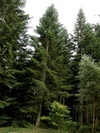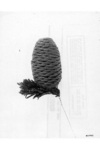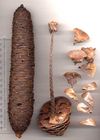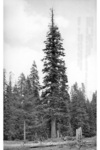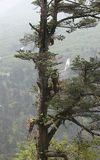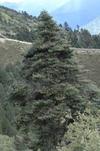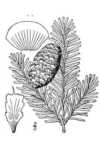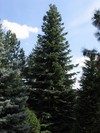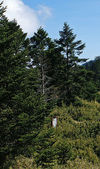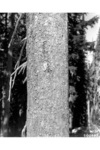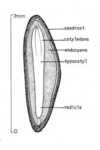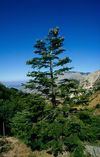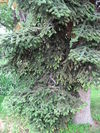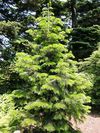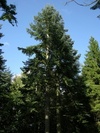Genus Abies
Firs are a genus of 48–55 species of evergreen conifers in the family Pinaceae.Species in the genus Abies of plants
Silver fir - The leaves are needle-like, flattened, 1.8–3 cm long and 2 mm wide by 0.5 mm thick, glossy dark green above, and with two greenish-white bands of stomata below. The tip of the leaf is usually slightly notched at the tip. The cones are 9–17 cm long and 3–4 cm broad, with about 150-200 scales, each scale with an exserted bract and two winged seeds; they disintegrate when mature to release the seeds.
Pacific silver fir - It is a large evergreen coniferous tree growing to 30–45 m tall The leaf arrangement is spiral on the shoot, but with each leaf variably twisted at the base so they lie flat to either side of and above the shoot, with none below the shoot. The shoots are orange-red with dense velvety pubescence. The cones are 9–17 cm long and 4–6 cm broad, dark purple before maturity; the scale bracts are short, and hidden in the closed cone. The winged seeds are released when the cones disintegrate at maturity about 6–7 months after pollination.
Balsam fir - It is a small to medium-size evergreen tree typically 14–20 metres tall, rarely to 27 metres tall, with a narrow conic crown. The bark on young trees is smooth, grey, and with resin blisters , becoming rough and fissured or scaly on old trees. The leaves are flat needle-like, 15 to 30 millimetres long, dark green above often with a small patch of stomata near the tip, and two white stomatal bands below, and a slightly notched tip. They are arranged spirally on the shoot, but with the leaf bases twisted to appear in two more-or-less horizontal rows. The cones are erect, 40 to 80 millimetres long, dark purple, ripening brown and disintegrating to release the winged seeds in September.
Baishan fir - Abies beshanzuensis is a species of conifer in the family Pinaceae. It is endemic to Baishanzu Shan in southern Zhejiang province in eastern China, where it grows at 1,850 m altitude and is threatened by collection and climate change.
Bulgarian Fir - It is a large evergreen coniferous tree growing to 40-50 m tall and with a trunk diameter of up to 1.5 m. The leaves are needle-like, flattened, 1.8-3.5 cm long and 2 mm wide by 0.5 mm thick, glossy dark green above, and with two blue-white bands of stomata below. The tip of the leaf is variable, usually pointed, but sometimes slightly notched at the tip, particularly on slow-growing shoots on older trees. The cones are 10-21 cm long and 4 cm broad, with about 150-200 scales, each scale with an exserted bract and two winged seeds; they disintegrate when mature to release the seeds.
Bristlecone fir - It is a tree 20-35 m tall, with a slender, spire-like form. The bark is reddish-brown with wrinkles, lines and resin vesicles . The branches are downswept. The needle-like leaves are arranged spirally on the shoot, but twisted at the base to spread either side of the shoot in two moderately forward-pointing ranks with a 'v' gap above the shoot; hard and stiff with a sharply pointed tip, 3.5-6 cm long and 2.5-3 mm broad, with two bright white stomatal bands on the underside. The cones are ovoid, 6-9 cm long , and differ from other firs in that the bracts end in very long, spreading, yellow-brown bristles 3-5 cm long; they disintegrate in autumn to release the winged seeds. The male cones are 2 cm long, shedding pollen in spring.
Greek Fir - The leaves are needle-like, flattened, 1.5-3 cm long and 2 mm wide by 0.5 mm thick, glossy dark green above, and with two blue-white bands of stomata below. The tip of the leaf is pointed, usually fairly sharply but sometimes with a blunt tip, particularly on slow-growing shoots on older trees. The cones are 10-20 cm long and 4 cm broad, with about 150-200 scales, each scale with an exserted bract and two winged seeds; they disintegrate when mature to release the seeds.
Abies cilicica - In 2009 at Berenice Troglodytica, the Egypto-Roman port on the Red Sea, archaeologists found: "two blocks of resin from the Syrian fir tree , one weighting about 190 g and the other about 339 g, recovered from 1st-century AD contexts in one of the harbor trenches. Produced in areas of greater Syria and Asia Minor, this resin and its oil derivative were used in mummification, as an antiseptic, a diuretic, to treat wrinkles, extract worms and promote hair growth."
White fir - The leaves are needle-like, flattened, 2.5-6 cm long and 2 mm wide by 0.5-1 mm thick, green to glaucous blue-green above, and with two glaucous blue-white bands of stomatal bloom below, and slightly notched to bluntly pointed at the tip. The leaf arrangement is spiral on the shoot, but with each leaf variably twisted at the base so they all lie in either two more-or-less flat ranks on either side of the shoot, or upswept across the top of the shoot but not below the shoot. The cones are 6-12 cm long and 4-4.5 cm broad, green or purple ripening pale brown, with about 100-150 scales; the scale bracts are short, and hidden in the closed cone. The winged seeds are released when the cones disintegrate at maturity about 6 months after pollination.
Delavay's Fir - The species is named after its discoverer, Father Pierre Jean Marie Delavay, who collected it at 3,500-4,000 m on the Cangshan mountains near Dali.
Sikkim fir - Abies densa is a conifer species in the family Pinaceae. It is sometimes included in the East Himalayan Fir as a variety.
Abies durangensis - Abies neodurangensis Debreczy, Racz et Salazar
Faber's fir - Abies fabri is a conifer species in the family Pinaceae. It is endemic to Sichuan in western China, occurring on the sacred mountain of Emei Shan and westward to the Gongga Shan massif, growing at altitudes of 1,500–4,000 m.
Fanjingshan Fir - Abies fanjingshanensis is a species of conifer in the Pinaceae family. It is found only in China. It is threatened by habitat loss.
Momi fir - Abies firma is a medium-sized to large evergreen coniferous tree growing to 50 m tall and 2 m in trunk diameter, with a broad conical crown of straight branches rising at an angle of about 20° above horizontal. The bark is scaly grey-brown, with resin blisters on young trees. The shoots are grooved, buff to grey-brown, glabrous or finely pubescent. The leaves are flattened, 2-5 cm long and 2-4 mm broad, spread at nearly right angles from the shoot; the apex is sharp, bifid on the leaves of young trees, single-pointed on mature trees. They are bright green above, and greyish-green below with two broad stomatal bands. The cones are 7-15 cm long by 3-5 cm wide, green maturing yellow-brown, tapering to a 2-3 cm broad bluntly rounded apex. The scale bracts are exserted 3-6 mm, triangular. The seeds are 7-9 mm long with a wedge-shaped wing 1.5 cm long, are released after the cones disintegrate at maturity in October.
Fraser fir - The species is named after the Scottish botanist John Fraser , who made numerous botanical collections in the region. It is sometimes mis-spelled as "Frazer" or "Frazier".
Grand fir - The leaves are needle-like, flattened, and grow in a single flat plane , 3–6 cm long and 2 mm wide by 0.5 mm thick, glossy dark green above, and with two green-white bands of stomata below, and slightly notched at the tip. The leaf arrangement is spiral on the shoot, but with each leaf variably twisted at the base so they all lie in two more-or-less flat ranks on either side of the shoot. The cones are 6–12 cm long and 3.5–4.5 cm broad, with about 100-150 scales; the scale bracts are short, and hidden in the closed cone. The winged seeds are released when the cones disintegrate at maturity about 6 months after pollination.
Guatemalan fir - A. guatemalensis is a conical tree growing 20 to 35 meters tall and 60 to 90 cm in girth. The branches grow largely horizontally. The bark is a blackish-brown and is divided into plates. The branchlets are reddish-brown to deep blackish-red and pubescent. The buds are globular-ovoid, resinous, and roughly 5 mm in length. The leaves are somewhat comb-like or nearly pectinate in arrangement. They are unequal and deep green above and waxy in texture underneath. They measure 1.5 to 5.5 cm long by 1.2 to 2 mm wide. Stomata are usually absent above, but appear in 8 to 10 lines below. They contain two marginal resin canals and the apex of the leaf is notched and emarginate. The female cones are oblong-cylindric and the apex is pointed to somewhat flattened. They are yellowish-brown in colour with a violet bloom and measure 8 to 11.5 cm long by 4 4.5 cm wide. The scales are oblong, or broader than long. The bracts are hidden, about one half the height of the scale and are cuneate-obovoid
Manchurian fir - It is an evergreen coniferous tree growing to 30 m tall and 1 m in trunk diameter with a narrowly conical crown of horizontal spreading branches. The bark is scaly and gray-brown with resin blisters. The leaves are flattened, 2-4 cm long and 1.5-2.5 mm thick, spread at right angles from the shoot, and end in a point. They are bright green above and whitish-green below with 7-10 stomatal bands. The shoots are glabrous, shiny yellow-gray when young and turning gray-brown. The cones are 12-14 cm long by 4-5 cm wide, yellow-brown, and slightly tapering with a bluntly rounded apex. The scale bracts are hidden under the cone scales. The seeds, 8-9 mm long with a wedge-shaped wing 1.5 cm long, are released after the cones disintegrate at maturity in October.
Nikko fir - It is a medium-sized to large evergreen coniferous tree growing to 30-40 m tall with a trunk diameter of up to 1.5 m. The leaves are needle-like, flattened, 1.5-3.5 cm long and 2-3 mm wide by 0.5 mm thick, glossy green above, and with two white bands of stomata below, and rounded or slightly notched at the tip. The leaf arrangement is spiral on the shoot, but with each leaf variably twisted at the base so they lie partially flattened to either side of and above the shoot, with few below the shoot. The shoots are yellow-buff, glabrous, and often conspicuously grooved. The cones are 6-12 cm long and 3-4 cm broad, purple-blue before maturity; the scale bracts are short, and hidden in the closed cone. The winged seeds are released when the cones disintegrate at maturity about 6–7 months after pollination.
Taiwan fir - Abies kawakamii is a species of conifer in the Pinaceae family. It is found only in Taiwan.
Korean Fir - It is a small to medium-sized evergreen coniferous tree growing to 10-18 m tall with a trunk diameter of up to 0.7 m, smaller and sometimes shrubby at tree line. The bark is smooth with resin blisters and grey-brown in colour. The leaves are needle-like, flattened, 1-2 cm long and 2-2.5 mm wide by 0.5 mm thick, glossy dark green above, and with two broad, vividly white bands of stomata below, and slightly notched at the tip. The leaf arrangement is spiral on the shoot, but with each leaf variably twisted at the base so they lie mostly either side of and above the shoot, with fewer below the shoot. The shoots are green-grey at first, maturing pinkish-grey, with scattered fine pubescence. The cones are 4-7 cm long and 1.5-2 cm broad, dark purple-blue before maturity; the scale bracts are long, green or yellow, and emerge between the scales in the closed cone. The winged seeds are released when the cones disintegrate at maturity about 5–6 months after pollination.
Subalpine fir - It is a medium-sized tree growing to 20 m tall, exceptionally to 40–50 m tall, with a trunk up to 1 m diameter, and a very narrow conic crown. The bark on young trees is smooth, gray, and with resin blisters, becoming rough and fissured or scaly on old trees. The leaves are flat needle-like, 1.5–3 cm long, glaucous green above with a broad stripe of stomata, and two blue-white stomatal bands below; the fresh leaf scars are reddish. They are arranged spirally on the shoot, but with the leaf bases twisted to be arranged to the sides of and above the shoot, with few or none below the shoot. The cones are erect, 6–12 cm long, dark blackish-purple with fine yellow-brown pubescence, ripening brown and disintegrating to release the winged seeds in early fall.
Red fir - Abies magnifica is a large evergreen tree typically up to 40–60 metres tall and 2 metres trunk diameter, rarely to 76.5 metres tall and 3 metres diameter, with a narrow conic crown. The bark on young trees is smooth, grey, and with resin blisters, becoming orange-red, rough and fissured on old trees. The leaves are needle-like, 2-3.5 cm long, glaucous blue-green above and below with strong stomatal bands, and an acute tip. They are arranged spirally on the shoot, but twisted slightly s-shaped to be upcurved above the shoot.
Maries's Fir - It is a medium-sized evergreen coniferous tree growing to 15-30 m tall with a trunk diameter of up to 0.8 m, smaller and sometimes shrubby at tree line. The leaves are needle-like, flattened, 1.5-2.5 cm long and 2 mm wide by 0.5 mm thick, matt dark green above, and with two white bands of stomata below, and slightly notched at the tip. The leaf arrangement is spiral on the shoot, but with each leaf variably twisted at the base so they lie flat to either side of and above the shoot, with none below the shoot. The shoots are orange-red with dense velvety pubescence. The cones are 5-11 cm long and 3-4 cm broad, dark purple-blue before maturity; the scale bracts are short, and hidden in the closed cone. The winged seeds are released when the cones disintegrate at maturity about 6–7 months after pollination.
Sicilian fir - Despite its scientific name, the species is presently limited to the steep, dry slopes of Mt. Scalone in the Madonie Mountains in the north-central part of Sicily.
Khinghan Fir - It is a medium-sized evergreen coniferous tree growing to 30 m tall with a trunk up to 1.2 m diameter and a narrow conic to columnar crown. The bark is grey-brown, smooth on young trees, becoming fissured on old trees. The leaves are flat needle-like, 10–30 mm long and 1.5–2 mm broad, green above, and with two dull greenish-white stomatal bands below; they are spirally arranged, but twisted at the base to lie flattened either side of and forwards across the top of the shoots. The cones are 4.5–7 cm long and 2–3 cm broad, green or purplish ripening grey-brown, and often very resinous; the tips of the bract scales are slightly exserted between the seed scales. Each seed scale bears two winged seeds, released when the cones disintegrate at maturity in the autumn.
Caucasian fir - It is a large evergreen coniferous tree growing to 60 m tall and with a trunk diameter of up to 2 m. In the Western Caucasus Reserve, some specimens have been reported to be 78 m and even 85 m tall, the tallest trees in Europe.
Algerian fir - Abies numidica is a medium-sized to large evergreen tree growing to 20–35 m tall, with a trunk up to 1 m diameter. The leaves are needle-like, moderately flattened, 1.5–2.5 cm long and 2–3 mm wide by 1 mm thick, glossy dark green with a patch of greenish-white stomata near the tip above, and with two greenish-white bands of stomata below. The tip of the leaf is variable, usually pointed, but sometimes slightly notched at the tip, particularly on slow-growing shoots on older trees. The cones are glaucous green with a pink or violet tinge, maturing brown, 10–20 cm long and 4 cm broad, with about 150–200 scales, each scale with a short bract and two winged seeds; they disintegrate when mature to release the seeds.
West Himalayan fir - It is a large evergreen tree growing to 40-60 m tall, and with a trunk diameter of up to 2-2.5 m. It has a conical crown with level branches.
Spanish Fir - Abies pinsapo is an evergreen tree growing to 20-30 m tall, with a conic crown, sometimes becoming irregular with age. The leaves are 1.5-2 cm long, arranged radially all round the shoots, and are strongly glaucous pale blue-green, with broad bands of whitish wax on both sides. The cones are cylindrical, 9-18 cm long, greenish-pink to purple before maturity, and smooth with the bract scales short and not exserted. When mature, they disintegrate to release the winged seeds.
Noble fir - Abies procera is a large evergreen tree typically up to 40–70 m tall and 2 m trunk diameter, rarely to 90 m tall and 2.7 m diameter, with a narrow conic crown. The bark on young trees is smooth, grey, and with resin blisters, becoming red-brown, rough and fissured on old trees. The leaves are needle-like, 1-3.5 cm long, glaucous blue-green above and below with strong stomatal bands, and a blunt to notched tip. They are arranged spirally on the shoot, but twisted slightly s-shaped to be upcurved above the shoot. The cones are erect, 11–22 cm long, with the purple scales almost completely hidden by the long exserted yellow-green bract scales; ripening brown and disintegrating to release the winged seeds in fall.
Sacred fir - It is a medium-sized to large evergreen coniferous tree growing to 25–50 m tall with a trunk diameter of up to 2 metres . The leaves are needle-like, flattened, 1.5–3.5 cm long and 1.5 mm wide by 0.5 mm thick, dark green above, and with two blue-white bands of stomata below; the leaf apex is acute. The leaf arrangement is spiral on the shoot, but with each leaf variably twisted at the base so they lie flat to either side of and above the shoot, with none below the shoot. The shoots are reddish-brown, hairless or with scattered pubescense. The cones are 8–16 cm long and 4–6 cm broad, dark blue-purple before maturity; the scale bracts are purple or greenish, of moderate length, with the tips exposed in the closed cone. The winged seeds are released when the cones disintegrate at maturity about 7–9 months after pollination. Trees from the western end of the range on Nevado de Colima, Jalisco have cones with larger, reflexed bract scales ; these are sometimes treated as a separate species, Abies co
Sakhalin Fir - The first "discovery" by a European was by Carl Friedrich Schmidt , the German botanist on the Russian island of Sakhalin in 1866, but he did not introduce it to Europe. The plant was re-discovered by the English plant-collector, Charles Maries in 1877 near Aomori on the main Japanese island of Honsh?, who initially thought it to be a variety of Abies veitchii.
Siberian fir - The tree lives in the cold boreal climate on moist soils in mountains or river basins at elevations of 1900-2400 m. It is very shade-tolerant, frost-resistant, and hardy, surviving temperatures down to ?50 °C. It rarely lives over 200 years due to the susceptibility to fungal decay in the wood.
Himalayan fir - Found in Afghanistan, China, India, and Nepal, it is not considered a threatened species by the IUCN.
Flaky fir - Abies squamata is a species of conifer in the Pinaceae family. It is found only in China.
Veitch's Fir - It is a coniferous evergreen tree growing at a fast rate to 25–30 m tall. The crown is narrowly conical with horizontal branches and pubescent shoots. The shoots are pubescent, with short brown hairs. The leaves are needle-like and flattened, 1–3 cm long and 2 mm broad. They are glossy dark green above with two conspicuous bluish white stomatal bands underneath, and the tips are notched. The foliage is dense and points forward along the shoot, with the inner leaves being shorter and more erect than the lower leaves. The cone is purple-brown, cylindrical, 4–7 cm long and tapers slightly. The cones are upright and have slightly exserted and reflexed yellow-green bracts. The bark is smooth and light grey, and has resin blisters characteristic of many firs.
Abies vejarii - It is a medium-sized evergreen tree growing to 35–40 m tall. The leaves are needle-like, moderately flattened, 1–2.5 cm long and 1.3–2 mm wide by 1 mm thick, grey-green with scattered stomata above, and with two greenish-white bands of stomata below. The tip of the leaf is acutely pointed. The cones are glaucous purple, maturing grey-brown, 6–15 cm long and 4–6 cm broad, with about 150–200 scales, each scale with a bract of which the apical 3–8 mm is exserted on the closed cone, and two winged seeds; they disintegrate when mature to release the seeds.

